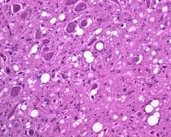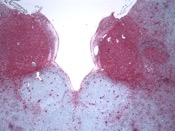Chronic Wasting Disease (CWD) in Cervids
By Dr. Brad Njaa
Introduction
Chronic wasting disease is a neurological disease found in elk, deer and moose (cervids). Researchers believe that the disease-causing agent is an infectious abnormal protein, called a prion, which is smaller than a virus. Prions (pronounced PREE-ons) attracted public attention during the bovine spongiform encephalopathy or “mad cow” epidemic that affected England in the 1980s.
The disease-causing prions enter brain cells and apparently convert normal prions found within the cells into abnormally-folded prions just like themselves. The abnormally-folded prions accumulate in the brain, causing death of brain cells and the development of microscopic holes. Pathologists describe these holes as “spongy change,” which has led to naming this group of diseases “spongiform” brain diseases (Figure 1). Because these diseases can be transmitted, CWD is part of a larger group of diseases referred to as Transmissible Spongiform Encephalopathies or TSE’s.
CWD transmission occurs through deer to deer contact. Recent research has determined that plants growing in contaminated areas can accumulate and retain infectious prions from the soil. There is no scientific evidence that CWD is transmissible to other animals through consuming meat from an infected deer. In addition, there is absolutely no evidence that humans can contract the disease by simply being in an area of Kansas where the disease has been found.

|
|
Figure 1. Spongiform changes in the brain stem due to CWD. |
The prion that causes CWD accumulates in certain parts of infected animals including: the brain, eyes, spinal cord, lymph nodes, tonsils, and spleen. Although there is no scientific evidence that CWD is transmissible to humans, health officials recommend that these parts not be eaten and also advise that no human or animal eat any part of a deer confirmed positive for CWD.
General precautions
- Do not eat the eyes, brain, spinal cord, spleen, tonsils or lymph nodes of any cervid.
- Do not eat any part of a cervid that appears sick.
- Test your cervid for CWD before consuming (Figure 2).
Test selection: Chronic Wasting Disease (CWD) histopathology
Specimens: obex, retropharyngeal lymph node in formalin
Turnaround time: 3-4 days
Cost: $23.75
- Wait for test results before eating the meat.

|
|
Figure 2. Strong positive for CWD in the obex. |
Suggested precautions for hunters when field-dressing cervids
- Wear rubber or latex gloves
- Minimize the handling of brain or spinal tissue. If removing antlers, use a saw designated for that purpose only, and dispose of the blade.
- Remove lymph nodes in/near joints
- Bone out meat from the deer and remove all fat and connective tissue. This will also remove lymph nodes.
- Do not cut through spinal column. Avoid using a saw.
- Identify and store meat and trimmings from each deer separately.
- Each hunter should get meat only from the animal he or she brought to you
- Thoroughly clean and sanitize equipment and work areas with bleach before using it for other processing. Use a solution of equal parts chlorine bleach and water. Wipe down countertops and let them dry. Soak items like knives one hour. When through, dilute the solution further and dump it down a drain.
- If you store meat until test results are available, work with owners to dispose of meat from animals that test positive for CWD.
Dr. Njaa is an anatomic pathologist in the Kansas State Veterinary Diagnostic Laboratory at Kansas State University.
Canine Bacterial Pyoderma: Indications and Skin Sampling Techniques
Return to Index